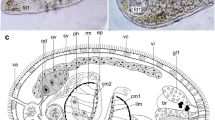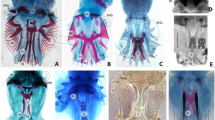Abstract
We present a molecular phylogeny of the Proteocephalidea based on 28S rDNA sequence data that is a follow-up to the paper by Zehnder & Mariaux (1999). Twenty-three new sequences, including three outgroups are added in our new data-set. The Gangesiinae Mola, 1929 and the Acanthotaeniinae Freze, 1963 appear to be the most primitive clades. They are followed by a robust clade comprising the Palaearctic Proteocephalinae Mola, 1929 from freshwater fishes. The structure of the more derived clades, comprising most Neotropical and Nearctic species, is less resolved. At the nomenclatural level, we erect a new genus, Glanitaenia n. g. for G. osculata (Goeze, 1782) n. comb., previously Proteocephalus osculatus, and define an aggregate for the Palaearctic Proteocephalus Weinland, 1858. After a re-examination of all of the studied taxa, we identify two types of uterine development and show the importance of this character for the systematics of the order. Our phylogeny does not support the classical view of a Neotropical origin for the Proteocephalidea but rather favours an Old World origin of the group either in saurians or Palaearctic Siluriformes.
Similar content being viewed by others
References
Beveridge, I. (1994) Family Anoplocephalidae Cholodkosky. 1902. In: Khalil L.F., Jones A. & Bray R.A. (Eds) Keys to the cestode parasites of vertebrates, Wallingford: CAB International, pp. 315–366.
Beveridge, I. (2003) Phylogenetic relationships of Anoplotaenia dasyuri (Cestoda) from dasyurid marsupials, with observations on uterine development in Cyclophyllideans. In: Combes, C. & Jourdane, J. (Eds). Taxonomie, écologie et évolution des métazoaires parasites. Livre-hommage à Louis Euzet. Perpignan: Presses Universitaires de Perpignan, Vol. 1, pp. 47–66.
Bona, F. (1994) Family Dilepididae Railliet & Henry, 1909. In: Khalil L.F., Jones A. & Bray R.A. (Eds) Keys to the cestode parasites of vertebrates, Wallingford: CAB International, pp. 443–554.
Brooks, D.R. (1978) Evolutionary history of the cestode order Proteocephalidea. Systematic Zoology, 27, 312–323.
Brooks, D.R., Hoberg, E.P. & Weekes P.J. (1991) Preliminary phylogenetic systematic analysis of the major lineages of the Eucestoda (Platyhelminthes: Cercomeria). Proceedings of the Biological Society of Washington, 104, 651–668.
Brooks, D.R. & Rasmussen, G. (1984) Proteocephalid cestodes from Venezuelan catfish, with a new classification of the Monticelliidae. Proceedings of the Biological Society of Washington, 97, 748–760.
Cañeda-Guzmán, I.C. (1997) Parásitos de tres especies de Marsupiales de la Estación 'Los Tuxtlas' y algunas zonas cercanas, Veracruz, México. BSc Thesis. Facultad de Ciencias, Universidad Nacional Autonóma de México, 193 pp.
Cañeda-Guzmán, I.C., de Chambrier, A. & Scholz, T. (2001) Thaumasioscolex didelphidis n. gen. and n. sp. (Eucestoda: Proteocephalidae) from the black-eared opossum Didelphis marsupialis fromMexico, the first proteocephalidean tapeworm from a mammal. Journal of Parasitology, 87, 639–646.
Carfora, M., de Chambrier, A. & Vaucher, C. (2003) Le genre Amphoteromorphus (Cestoda: Proteocephalidea), parasite de poissons-chats d'Amérique tropicale: étude morphologique et approche biosystématique par électrophorèse des protéines. Revue Suisse de Zoologie, 110, 381–409.
de Chambrier, A. (1988) Crepidobothrium garzonii n. sp. (Cestoda: Proteocephalidae) parasite de Bothrops alternatus Dum. Bibr. & Dum.1854 (Serpentes: Viperidae) au Paraguay. Revue Suisse de Zoologie, 95, 1163–1170.
de Chambrier, A. (1990) Redescription de Proteocephalus paraguayensis (Rudin, 1917) (Cestoda: Proteocephalidae) parasite de Hydrodynastes gigas (Dum., Bibr. & Dum., 1854) du Paraguay. Systematic Parasitology, 16, 85–97.
de Chambrier, A., d'Alessio, M.L. & de Azevedo Corrêa, F.M. (1991) Redescription de Proteocephalus jarara (Fuhrmann, 1927) (Cestoda: Proteocephalidae) parasite de Bothrops alternatus (Viperidae) au Brésil. Revue Suisse de Zoologie, 98, 15–32.
de Chambrier, A. & Vaucher, C. (1994) Etude morpho-anatomique et génétique de deux nouveaux Proteocephalus Weinland, 1858 (Cestoda: Proteocephalidae) parasites de Platydoras costatus (L.), poisson siluriforme du Paraguay. Systematic Parasitology, 27, 173–185.
de Chambrier, A. & Vaucher, C. (1997) Révision des cestodes (Monticelliidae) décrits par Woodland (1934) chez Brachyplatystoma filamentosum avec redéfinition des genres Endorchis Woodland, 1934 et Nomimoscolex Woodland, 1934. Systematic Parasitology, 37, 219–233.
de Chambrier, A. & Vaucher, C. (1999) Proteocephalidae et Monticelliidae (Eucestoda: Proteocephalidea) parasites de poissons d'eau douce au Paraguay, avec descriptions d'un genre nouveau et de dix espèces nouvelles. Revue Suisse de Zoologie, 106, 165–240.
Euzet, L. (1982) Problèmes posés par la spécificité parasitaire des cestodes Proteocephalidea et Pseudophyllidea parasites de poissons. Mémoires du Museum d'Histoire Naturelle, Série A, Zoologie, 123, 279–287.
Fischer, H. & Freeman, R.S. (1969) Penetration of parenteral plerocercoids of Proteocephalus ambloplitis (Leidy) into the gut of smallmouth bass. Journal of Parasitology, 55, 766–774.
Freze, V.I. (1965) [Essentials of Cestodology.] Vol. V. [Proteocephalata in fish, amphibians and reptiles.] Moskva: Izdatel'stvo Nauka, 538 pp. (In Russian: English translation, Israel Program of Scientific Translation, 1969, Cat. No. 1853. v + 597 pp).
Gil de Pertierra, A.A. & de Chambrier, A. (2000) Rudophiella szidati sp. n. (Proteocephalidea: Monticelliidae, Rudolphiellinae) parasite of Luciopimelodus pati (Valenciennes, 1840) (Pisces: Pimelodidae) from Argentina with new observations on Rudolphiella lobosa (Riggenbach, 1895). Revue Suisse de Zoologie, 107, 81–95.
Goeze, J.A.E. (1782) Versuch einer Naturgeschichte der eingeweidewürmer tierischer Körper. Blankenburg, 471 pp.
Hanzelová, V. & Scholz, T. (1999) Species of Proteocephalus Weinland, 1858 (Cestoda: Proteocephalidae), parasites of coregonid and salmonid fishes from North America: taxonomic reappraisal. Journal of Parasitology, 85, 94–101.
Hanzelová, V., Scholz, T. & Fagerholm, H.-P. (1995) Synonymy of Proteocephalus neglectus La Rue, 1911 with P. exiguus La Rue, 1911, two fish cestodes from the Holarctic Region. Systematic Parasitology, 30, 173–185.
Hoberg, E.P., Jones, A. & Bray, R.A. (1999) Phylogenetic analysis among the families of the Cyclophyllidea (Eucestoda) based on comparative morphology, with new hypotheses for co-evolution in vertebrates. Systematic Parasitology, 42, 51–73.
Hoffman, G.L. (1999) Parasites of North American freshwater fishes. Second Edition. Ithaca & London: Comstock Publishing Associates, Cornell University Press, 539 pp.
International Code of Zoological Nomenclature (1999) Fourth Edition. London: The International Trust for Zoological Nomenclature, xxix + 306 pp.
Kodedová, I., Dolezel, D., Broucková, M., Jirku, M., Hypsa, V., Lukes, J. & Scholz, T. (2000) On the phylogenetic positions of the Caryophyllidea, Pseudophyllidea and Proteocephalidea (Eucestoda) inferred from 18S rRNA. International Journal for Parasitology, 30, 1109–1113.
La Rue, G.R. (1911) A revision of the cestode family Proteocephalidae. Zoologischer Anzeiger, 38, 473–482.
La Rue, G.R. (1914) A revision of the cestode family Proteocephalidae. Illinois Biological Monographs, 1, 1–349.
Lockyer, A.E., Olson, P.D. & Littlewood, D.T.J. (2003) Utility of complete large and small subunit rRNA genes in resolving the phylogeny of the Neodermata (Platyhelminthes): implications and a review of the cercomer theory. Biological Journal of the Linnean Society, 78, 155–171.
Lundberg, J.G., Marshall, L.G., Guerrero, J., Horton, B., Malabarba, M.C.S.L. & Wesselingh, F. (1998) The stage for Neotropical fish diversification: A history of tropical south American rivers. In: Malabarba, L.R., Reis, R.E., Vari, R.P., Lucena, Z.M.S. & Lucena, C.A.S. (Eds) Phylogeny and classification of Neotropical fishes. Porto Alegre: Edipucrs, pp. 13–48.
Mariaux, J. (1998) A molecular phylogeny of the Eucestoda. Journal of Parasitology, 84, 114–124.
Mariaux, J. & Olson, P.D. (2001) Cestode systematics in the molecular era. In: Littlewood, D.T.J & Bray, R.A. (Eds). Interrelationships of the Platyhelminthes. London: Taylor & Francis, pp. 127–134.
Mo, T. (1991) Anatomy and systematics of Bagridae (Teleostei), and siluroid phylogeny. Königstein: Koeltz Scientific Books, 216 pp.
Nybelin, O. (1942) Zur Helminthen Fauna der Süsswasserfische Schwedens. II. Die Cestodes desWelses. Göteborgs Kungl Vetenkaps Och Vitterhets-samhalles Handlingar Series B1, 1–24.
Olson, P.D., Cribb, T.H., Tkach, V.V., Bray, R.A. & Littlewood, D.T.J. (2003) Phylogeny and classification of the Digenea (Platyhelminthes: Trematoda). International Journal for Parasitology, 33, 733–755.
Olson, P.D. & Littlewood, D.T.J. (2002) Phylogenetics of the Monogenea-evidence from a medley of molecules. International Journal for Parasitology, 32, 233–244.
Olson, P.D., Littlewood, T.J., Bray, R.A. & Mariaux, J. (2001) Interrelationships and evolution of the tapeworms (Platyhelminthes: Cestoda). Molecular Phylogenetics and Evolution, 19, 443–467.
Rego, A.A. (1994) Order Proteocephalidea Mola, 1928. In: Khalil L.F., Jones A. & Bray R.A. (Eds) Keys to the cestode parasites of vertebrates, Wallingford: CAB International, pp. 257–293.
Rego, A.A. (1995) A new classification of the cestode order Proteocephalidea Mola. Revista Brasileira de Zoologia, 12, 791–814.
Rego, A.A. & de Chambrier, A. (1995) Crepidobothrium eirasi n. sp. (Cestoda: Proteocephalidae), a parasite of the siluroid fish Phractocephalus hemioliopterus (Schneider, 1801) (Pisces: Pimelodidae) from the Brazilian Amazon. Revue Suisse de Zoologie, 102, 3–11.
Rego, A.A., de Chambrier, A., Hanzelová, V., Hoberg, E., Scholz, T., Weekes, P. & Zehnder, M. (1998) Preliminary phylogenetic analysis of subfamilies of the Proteocephalidea (Eucestoda). Systematic Parasitology, 40, 1–19.
Rego, A.A., Chubb, J.C. & Pavanelli, G. C. (1999) Cestodes in South American freshwater teleost fishes: keys to genera and brief description of species. Revista Brasileira de Zoologia, 16, 299–367.
Rego, A.A. & Ivanov, V. (2001) Pseudocrepidobothrium eirasi (Rego and de Chambrier, 1995) gen. n. and comb. nov. (Cestoda, Proteocephalidea), parasite of a South American freshwater fish, and comparative cladistic analysis with Crepidobothrium spp.Acta Scientarum, 23, 363–367.
Rego, A.A., Machado, P.M. & Pavanelli, G.C. (1999) Sciadocephalus megalodiscus Diesing, 1850 (Cestoda: Corallobothriinae) a parasite of Cichla monoculus Spix, 1831 (Cichlidae), in the Paraná River, State of Paraná, Brazil. Journal of the Helminthological Society of Washington, 66, 133–137.
Rødland, J.T. (1983) A redescription of the cestodes Proteocephalus filicollis (Rudolphi) from Gasterosteus aculeatus L., and P. ambiguus (Dujardin) from Pungitius pungitius (L.). Zoologica Scripta, 12, 19–23.
Schmidt, G.D. (1986) CRC Handbook of tapeworm identification. Boca Raton: CRC Press, 675 pp.
Scholz, T. (1999) Life cycles of species of Proteocephalus, parasites of fishes in the Palearctic Region: a review. Journal of Helminthology, 73, 1–18.
Scholz, T. & de Chambrier, A. (2003) Taxonomy and biology of proteocephalidean cestodes: current state and perspectives. Helminthologia, 40, 65–77.
Scholz, T., Drábek, R. & Hanzelová, V. (1998) Scolex morphology of Proteocephalus tapeworms (Cestoda: Proteocephalidae), parasites of freshwater fish in the Palaearctic Region. Folia Parasitologica, 45, 27–43.
Scholz, T. & Hanzelová, V. (1998) Tapeworms of the genus Proteocephalus Weinland, 1858 (Cestoda: Proteocephalidae), parasites of fishes in Europe. Studie AV CR. Prague: Academia, 119 pp.
Scholz, T. & Hanzelová, V. (1999) Species of Proteocephalus Weinland, 1858 (Cestoda: Proteocephalidae) from cyprinid fishes in North America. Journal of Parasitology, 85, 150–154.
Shimazu, T. (1993) Redescription of Paraproteocephalus parasiluri (Yamaguti, 1934) n. comb. (Cestoidea: Proteocephalidae), with notes on four species of the genus Proteocephalus, from Japanese freshwater fishes. Journal of the Nagano Prefectural College, 48, 1–9.
Skeríková, A., Hypsa, V. & Scholz, T. (2001) Phylogenetic analysis of European species of Proteocephalus (Cestoda: Proteocephalidea): compatibility of molecular and morphological data, and parasite-host coevolution. International Journal for Parasitology, 31, 1121–1128.
Swofford, D.L. (2002) PAUP?. Phylogenetic analysis using parsimony (?and other methods). Version 4.0b10.Sunderland, Massachussets: Sinauer Associates.
Telford, M.J., Lockyer, A.E., Cartwright, C. & Littlewood, D.T.J. (2003) Combined large and small subunit ribosomal RNA phylogenies support a basal position of the acoelomorph flatworms. Proceedings of the Royal Society of London B, 270, 1077–1083.
Willemse, J.J. (1968) Proteocephalus filicollis (Rudolphi, 1802) and Proteocephalus ambiguus (Dujardin, 1845), two hitherto confused species of cestodes. Journal of Helminthology, 42, 395–410.
Woodland, W.N.F. (1934) On some remarkable new cestodes from the Amazon siluroid fish, Brachyplatystoma filamentosum (Lichtenstein). Parasitology, 26, 268–277.
Woodland, W.N.F. (1935) Additional cestodes from the Amazon siluroids Pirarará, Dorad and Sudobim. Proceedings of the Zoological Society of London, 104, 851–862.
Zehnder, M.P. & Mariaux, J. (1999) Molecular systematic analysis of the order Proteocephalidea (Eucestoda) based on mitochondrial and nuclear rDNA sequences. International Journal for Parasitology, 29, 1841–1852.
Zehnder, M.P. & de Chambrier, A. (2000) Morphological and molecular analyses of the genera Peltidocotyle Diesing, 1850, Othinoscolex and Woodlandiella (Eucestoda, Proteocephalidea), parasites of South American siluriform fishes (Pimelodidae). Systematic Parasitology, 46, 33–43.
Zehnder, M.P., de Chambrier, A., Vaucher, C. & Mariaux, J. (2000) Nomimoscolex suspectus n. sp. (Eucestoda: Zygobothriinae) with morphological and molecular phylogenetic analysis of the genus. Systematic Parasitology, 47, 157–172.
Author information
Authors and Affiliations
Rights and permissions
About this article
Cite this article
de Chambrier, A., Zehnder, M., Vaucher, C. et al. The evolution of the Proteocephalidea (Platyhelminthes, Eucestoda) based on an enlarged molecular phylogeny, with comments on their uterine development. Syst Parasitol 57, 159–171 (2004). https://doi.org/10.1023/B:SYPA.0000019083.26876.34
Issue Date:
DOI: https://doi.org/10.1023/B:SYPA.0000019083.26876.34




